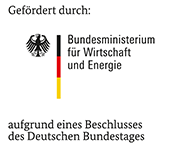15647 N

| Period: | 01.05.2008 - 31.10.2010 |
|---|---|
| Funder: | AiF |
| Project Manager: | Dr. Florian Feil |
| Research Group: | Corrosion |
As the mobility of our society increases and fuel prices rise the demand for light materials in transport and electronic industries accrues. The interest in magnesium as the lightest construction metal is high. But this highly reactive metal demands excellent corrosion protection. Most coatings used nowadays, based on organic or organic/inorganic hybrid materials, are not stable under thermal exposure or mechanical impact or their application is environmentally untenable.
Due to their large surface area and short diffusion paths nanoparticles densify at relatively low temperatures. Therefore this project uses chemical nanotechnology to apply dense, protective, purely inorganic and transparent coatings onto magnesium alloys under conditions which are suitable even for these thermally precarious materials and which also offer high thermal and mechanical resistance.
Coating sols are based on SiO2 and sintering additives like B2 O3 . Composition and application is adapted mainly to reduce the sintering temperature and increase the barrier function of these coatings. Commercial aqueous and base stabilized colloidal SiO2 dispersions can be used for dip and brush coating applications. Here the sintering additives can easily be added as salts.
Another way to coat magnesium is electrophoretic deposition. Because only solid compounds can be deposited with this method, all sintering additives have to be contained in the particles. Mixed oxide particles with a diameter between 10 and 500nm and low polydispersity can easily be obtained by a basic sol gel process. Promoters like polydiethoxysiloxane improve the adhesion on magnesium and also between the particles. Using mixtures of different particle sizes can help to increase coating thickness and density. Additionally concentration gradients of different oxides within these particles can tune the coating properties, too.
With these methods crack-free coatings are developed on the wrought alloy AZ31 as well as on the cast alloy AZ91 with a thickness of up to several micrometers, which help to improve the corrosion performance of the magnesium substrates. The corrosion protection properties of these coatings and their chemical and mechanical resistance are investigated using standard tests as well as electrochemical methods.
back
Das IGF-Vorhaben Nr. 15647 N der Forschungsvereinigung DECHEMA e.V., Theodor-Heuss-Allee 25, 60486 Frankfurt am Main wurde über die AiF im Rahmen des Programms zur Förderung der industriellen Gemeinschaftsforschung (IGF) vom Bundesministerium für Wirtschaft und Energie aufgrund eines Beschlusses des Deutschen Bundestages gefördert.
Contact |
| Prof. Dr.-Ing. Wolfram Fürbeth |
| Telefon: +49 69 / 75 64-398 E-Mail: fuerbeth |
Publications |
| F. Feil, W. Fürbeth, M. Schütze Surface Engineering 24 (2008) 198-203 |
| F. Feil, W. Fürbeth, M. Schütze Electrochimica Acta 54 (2009) 2478-2486 |